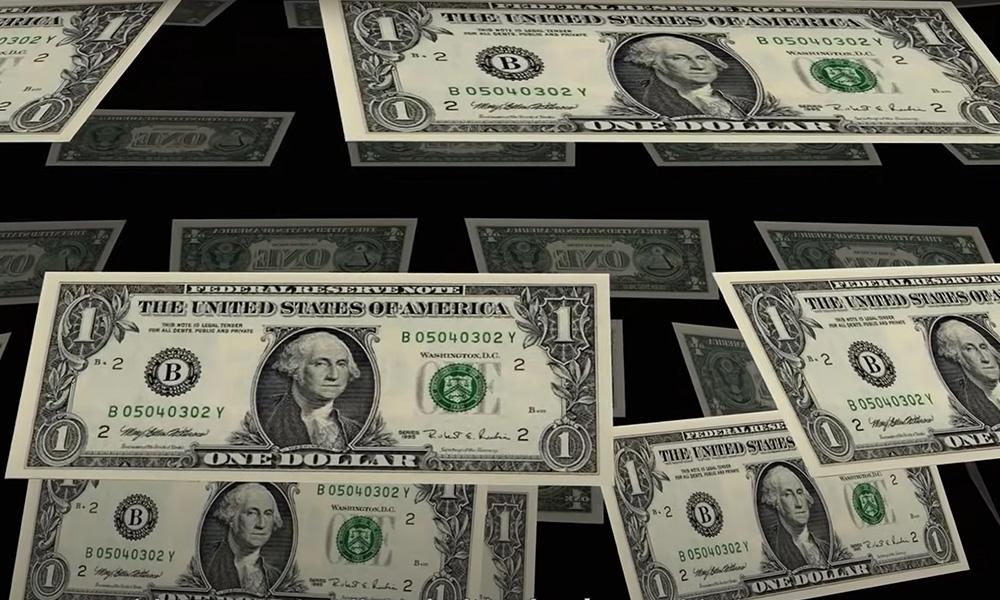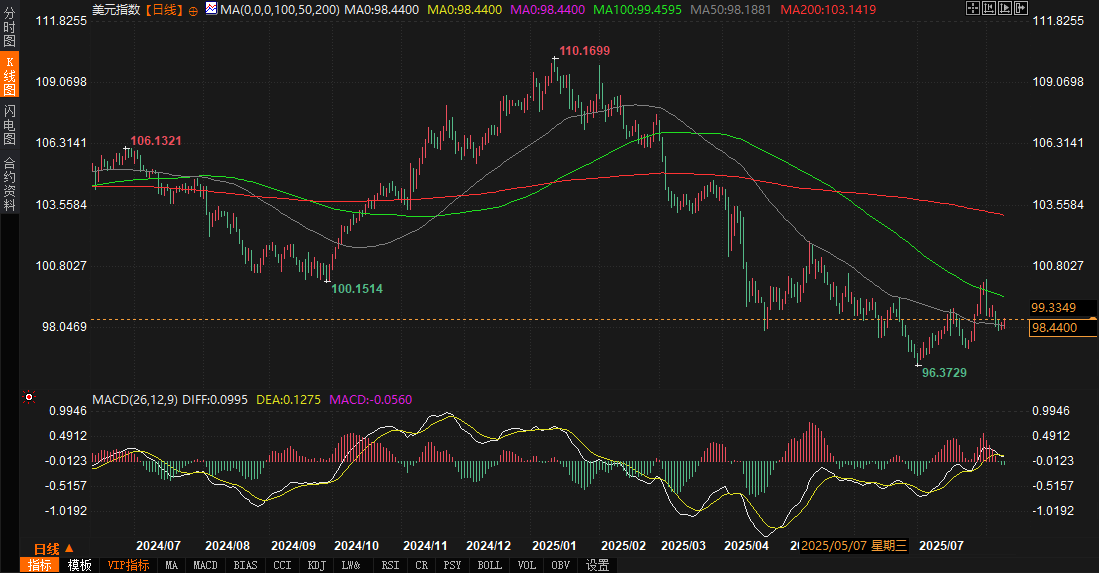A tug-of-war over the 4.30% US Treasury yield! The US dollar is at 98.50, and CPI could be the catalyst for a breakthrough!
2025-08-11 21:16:38

Fundamental analysis: Market drivers driven by multiple factors
Recently, the performance of the US dollar and the US Treasury market has been driven by a combination of fundamental factors. First, the core variable is the change in expectations for the Federal Reserve's monetary policy. The market's expectation of a Fed rate cut in September is almost certain, and interest rate futures indicate that there may be room for nearly two more rate cuts this year. This is mainly due to the weak July non-farm payroll data (an increase of only 73,000) and the downward revision of employment data in previous months. These data have exacerbated market concerns about slowing US economic growth, pushing downward pressure on short-term US Treasury yields (such as the 2-year Treasury yield). The latest 2-year Treasury yield is 3.76%, down about 25 basis points from mid-July. However, well-known institutional strategists point out that the pace of the Fed's rate cuts may be constrained by inflationary pressures. A senior analyst said: "Although the Fed tends to loosen its policy, if inflation data continues to exceed expectations, it may limit the extent of rate cuts."
Secondly, the anti-tariff effect triggered by tariff rhetoric has significantly impacted market sentiment. Trump's recent tariff rhetoric has heightened market concerns about rising inflation. This is particularly true given the US federal debt has reached $36.5 trillion. New debt issuance could further push up long-term Treasury yields. Leading institutions predict that the 10-year Treasury yield may rise slightly to 4.30% over the next three months and remain near this level in early 2026, reflecting the market's dual considerations of fiscal deficits and inflation expectations. Furthermore, uncertainty surrounding the Russia-Ukraine situation has further fueled risk aversion, leading to some inflows into US dollar assets and supporting a short-term rebound in the US dollar index.
The market will also need to pay attention to the US July CPI data, due to be released on Tuesday. Expectations suggest inflation may rise further, with core PCE inflation potentially rising from 2.4% to 3.1% if full tariffs are imposed. This will challenge the Federal Reserve's policy path, and the market's sensitivity to inflation data could trigger short-term fluctuations in US Treasury yields and the US dollar index. Some traders have noted that the upward trend in long-term US Treasury yields may continue due to fiscal deficit concerns. Combined with the impact of tariff rhetoric, market attention to inflation has significantly increased.
Furthermore, potential political pressure on the Federal Reserve's independence has become a focal point of market discussion. Trump's recent criticism of Fed Chairman Powell and official data has sparked market concerns about the credibility of the central bank's policies, pushing up the term premium on long-term U.S. Treasuries. A fixed income strategist stated, "Increased fiscal deficits and debt issuance mean higher yields are needed to attract buyers, which will support long-term Treasury yields."
Technical analysis: Trends and signals for the US dollar and US Treasuries
From a technical perspective, the US Dollar Index (DXY) is currently trading at 98.4570, up 0.21% on the day, but generally in a volatile pattern. The daily chart shows that the US Dollar Index has stabilized above its 50-day moving average (98.1886), indicating a slight bullish advantage in the short term. However, the 100-day moving average (99.4597) and the 200-day moving average (103.1420) still provide overhead resistance, indicating that the US Dollar has not yet fully reversed its medium- to long-term downward trend. The MACD indicator (26, 12, 9) shows that the DIFF line (0.1007) has just crossed below the DEA line (0.1277), with a MACD value of 0.0545, suggesting weakening short-term momentum and potential for a correction. Considering recent market sentiment, the US Dollar Index is likely to continue to fluctuate between 98.00 and 99.00. Close attention should be paid to the direction of the breakout following the release of the CPI data.

In the U.S. Treasury market, the 10-year Treasury yield was at 4.27%, down slightly from the previous week's high of 4.283, with an intraday range of 4.256-4.275. The yield spread between the 2-year and 10-year bonds widened to 80 basis points from 50 basis points on Monday, indicating a further steepening of the yield curve. The SOFR futures market indicated a downward revision in short-term interest rate expectations, with the SRAU25 (white plate) price at 95.915, down 1 basis point from the previous day, reflecting increased market expectations for a Federal Reserve rate cut. Long-term Treasury yields are supported by debt supply and inflation expectations, with limited downside potential in the short term. Traders noted that the 30-year Treasury yield, which broke through 5% to reach a two-year high, demonstrates bullish sentiment on long-term yields.
In the swap market, swap spreads have widened slightly recently, but still lag behind fluctuations in US Treasury yields. The 2-year swap spread was reported at -24.25, up 0.25 basis points from the previous day. This reflects the market's focus on the supply of investment-grade bonds, with issuance expected to reach $30-40 billion this week, potentially pushing up long-term yields. Technically, the 10-year US Treasury yield is fluctuating between 4.20 and 4.30. If it breaks above 4.30, it could test the year-to-date high of 4.50.
Market linkage analysis: the interaction between US Treasuries and the US dollar
The correlation between US Treasury yields and the US dollar index is particularly pronounced in the current market environment. Short-term US Treasury yields (2-year and 3-year) have come under downward pressure due to expectations of a Federal Reserve rate cut, directly weakening the US dollar's interest rate support and causing the US dollar index to fall by over 5% between July and August. However, long-term US Treasury yields (10-year and 30-year) have remained firm due to tariff rhetoric and debt supply pressures, partially offsetting the downward impact of short-term yields and supporting safe-haven demand for the US dollar. Traders believe the upward trend in long-term US Treasury yields may continue due to fiscal deficit concerns, providing potential support for the US dollar.
Furthermore, geopolitical risks arising from the Russia-Ukraine situation have fueled risk aversion, leading to some inflows into US dollar assets and further solidifying the US dollar index's support level near 98.00. However, inflation expectations fueled by tariff rhetoric could indirectly impact the dollar's performance by pushing up US Treasury yields. If inflation data exceeds expectations, the Federal Reserve's rate cut pace could slow, potentially pushing the dollar above its 100-day moving average. Conversely, if inflation data is mild, the dollar could retreat below its 50-day moving average.
Future Trend Outlook
Looking ahead to the week ahead, the direction of the US dollar and US Treasury markets will be highly dependent on the upcoming July CPI data and the outcome of the talks on the Russia-Ukraine situation. If the CPI data confirms a sustained upward trend in inflation, long-term US Treasury yields could break through 4.30, testing the year-to-date high of 4.50, and the US dollar index could challenge its 100-day moving average (99.4597). Conversely, if inflation data falls short of expectations, short-term US Treasury yields could fall further, with the US dollar index potentially falling below 98.00, testing support at its 50-day moving average. The yield curve steepening trend is expected to continue, with the 2-year to 10-year yield spread potentially widening to 80-100 basis points, reflecting continued market focus on fiscal deficits and inflation expectations.
Regarding geopolitical risks, uncertainty surrounding the Russia-Ukraine situation may continue to fuel risk aversion, providing short-term support for the US dollar. However, if the situation eases, safe-haven demand may weaken, potentially putting the US dollar under downward pressure. Technically, the US dollar index is likely to fluctuate within the 98.00-99.50 range, and attention should be paid to whether the MACD indicator confirms further downward signals. In the US Treasury market, the downward potential of long-term yields is limited by debt supply and inflation expectations. In the short term, fluctuations in the 4.20-4.50 range are likely, with a breakout of 4.30 for the 10-year yield being a key indicator. In summary, driven by both fundamentals and technical factors, the US dollar and US Treasury markets will maintain high volatility in the short term. Traders should closely monitor CPI data, developments in the Russia-Ukraine situation, and Federal Reserve policy signals to identify directional market shifts.
- Risk Warning and Disclaimer
- The market involves risk, and trading may not be suitable for all investors. This article is for reference only and does not constitute personal investment advice, nor does it take into account certain users’ specific investment objectives, financial situation, or other needs. Any investment decisions made based on this information are at your own risk.





















